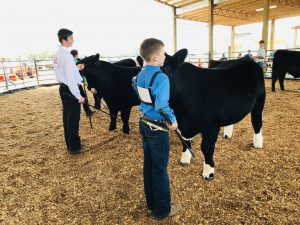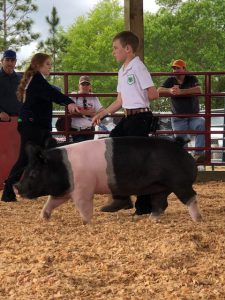Many people are spending extra time at home these days, and are looking to work on their cooking skills and trying new products. Warmer weather usually means you start rolling out the grills and getting ready for delicious steaks or ribs for your family to enjoy. Closures of several beef and pork packing plants across the country have many citizens worried about meat supply and prices at super markets and restaurants. While retailers are working to continue to provide an adequate supply of safe and affordable meat, there may be people in your community all along that are ready and able to supply safe, wholesome products for your family – local farmers and ranchers.
Local farmers have been a staple of communities for many years. You’ve seen them in the market, the hardware store and at the local restaurants, but you may have never thought about them as a potential source for many of the items you often get at the local supermarket. Buying products directly from the farm is certainly not a new idea. During these uncertain times, local farmers have become shining stars, providing vegetables, fruits, nuts, berries and even meat for local charities and schools. While farmer’s markets are an option to connect with local producers for fresh produce, there are also farmers and ranchers willing to connect with consumers to provide the meat products you want.
For those of you looking specifically for meat, there are several ways you can get your hands on these products. Freezer beef, as it is commonly called, is the term used by producers for meat that goes directly from the farmer to the consumer. Purchasing direct is not as easy as simply walking down the isle at the supermarket, but with a little help it can be a fun process. Let’s go over some tips and tricks to help you when make your buying decisions.
–
Finding beef to purchase direct from producers
 This first order of business is fairly obvious – locate sources of locally produced meat. Local beef or swine producers should be very familiar with the process and can guide you to contacts they have. They are also a wealth of knowledge about the animals from their farm that are raised for meat. For example, they can let you know how they were raised on their farm, and when they might have product avaialbe. They can also provide you with information about particular cuts of meat. Perhaps you only want ground meat, such as hamburger meat or sausage – let them know what you’re looking for.
This first order of business is fairly obvious – locate sources of locally produced meat. Local beef or swine producers should be very familiar with the process and can guide you to contacts they have. They are also a wealth of knowledge about the animals from their farm that are raised for meat. For example, they can let you know how they were raised on their farm, and when they might have product avaialbe. They can also provide you with information about particular cuts of meat. Perhaps you only want ground meat, such as hamburger meat or sausage – let them know what you’re looking for.
Another great resource for meat is your local 4-H or FFA youth, who raise and show animals as part of their annual program projects. These animals are usually purchased by the youth from a trusted farmer, and they will care for and train the animals to be shown at local and regional shows. These animal projects usually culminate at a county fair, and the animals will be auctioned off at the end. Proceeds of the sale go directly to the youth to continue their animal projects in the future. Just as farmers do, youth must maintain strict records on their project animals, to ensure the buyer gets a quality project. Purchasing from 4-H and FFA youth is a great way to support your future leaders in the area.
How much do I need to buy?
 Deciding how much you want to buy is important to know prior to reaching out to producers or youth. Typically you will need to know how much freezer space you have to adequately store your meat. In general, producers like to finish cattle (meaning they are at the end of their meat and fat development) at around 1200-1300 pounds. You will certainly not get 1200 pounds of edible meat, but that can give you a starting place to calculate how much meat you can expect after harvest. Generally, cattle will yield (produce) about 58% of the total weight in retail cuts (these are ones you see generally in the supermarket.) So if you do the math, a 1250 pound steer will yield 725 lbs. of retail product. Keep in mind that some of this will include bones, depending on the cut. You now have 725 lbs. of product that must be broken down into cuts: steaks, roasts, brisket and so on. This is where it is important to have a good relationship with the producer and/or a local butcher. Some producers even allow you to on buy portions of an animal, often they will split the carcass into halves to sell to two families.
Deciding how much you want to buy is important to know prior to reaching out to producers or youth. Typically you will need to know how much freezer space you have to adequately store your meat. In general, producers like to finish cattle (meaning they are at the end of their meat and fat development) at around 1200-1300 pounds. You will certainly not get 1200 pounds of edible meat, but that can give you a starting place to calculate how much meat you can expect after harvest. Generally, cattle will yield (produce) about 58% of the total weight in retail cuts (these are ones you see generally in the supermarket.) So if you do the math, a 1250 pound steer will yield 725 lbs. of retail product. Keep in mind that some of this will include bones, depending on the cut. You now have 725 lbs. of product that must be broken down into cuts: steaks, roasts, brisket and so on. This is where it is important to have a good relationship with the producer and/or a local butcher. Some producers even allow you to on buy portions of an animal, often they will split the carcass into halves to sell to two families.
–
What do I need to tell the butcher?
There is particular information that a butcher might ask when preparing your order. They are going to want to know information such as:
- How much hamburger meat do you want?
- You want your hamburger meat in 1, 1.5, 2 pound or bigger packages
- How thick do you want your steaks cut?
- Bone in or out?
- Do you want your meat wrapped in paper or vacuum sealed?
These are just some of the things that you will need to consider as you customize your order. This example beef cut sheet can show many of the options that local butchers can provide. Keep in mind that the more time the butcher spends breaking down the cuts, the greater the processing cost will be.
–
How much can I expect to pay?
This question can be one of the biggest deciding factors when it comes to purchasing animals and meat directly from the producer. Depending on the circumstances, you may be purchasing a live animal, and working with the producer and butcher to get it processed to your specifications. Note: if the butcher shop is not a USDA certified venue, meaning they have an inspector on the processing floor, the meat must be for personal consumption and not be resold. You also will need to figure out if you’re purchasing based on the live weight (how much the live animal weighs prior to processing) or the hanging weight (the dressed carcass weight – after removal of hide, internal organs, blood drained, etc). This can play a large role in what your end costs will be. If you purchase from a youth exhibitor, often times you will pay for the live weight at the fair, and these funds go to the youth. You will then be responsible for the processing costs at the butcher. These items need to be agreed upon by you and the exhibitor. Price per pound can vary greatly depending on the region that you’re in, the type of meat your buying, and if the exhibition animal happens to win champion (these usually bring more of a premium). Start by reaching out to local resources such as your Extension Office, Farm Bureau, farmers market and even social media.
In summary, remember that when you are purchasing directly from producers or youth, you are helping to support agriculture production in your area, and are helping future generations. You can also take pride in knowing that you personally know how that animal was raised and how well it was taken care of. You can also develop long lasting relationships that can supply you with healthy products for years to come. Good luck in your search for locally sourced meat.
–
Additional resources:
Fresh Meat Selection for Consumers
USDA-Inspected Livestock Slaughter Facilities in Florida
Beef Retail Identification Cuts
How Much Meat to Expect from a Beef Carcass
- 2026 Santa Rosa CountyRow Crop Production Meeting – January 22 - December 19, 2025
- Hay Quality and Quantity Considerations for Winter Feeding - September 5, 2025
- Managing Lice on Cattle - February 28, 2025
